Beets were not a vegetable that I grew up eating, but I fell in love with their earthy sweetness during my days working in restaurants. That earthiness can be a hurdle for some, but there are many varieties of beets and many ways to prepare them to suit different tastes.
Plus, these root vegetables have a versatility that’s hard to beat: they’re great raw, roasted, pickled and even juiced to color desserts. Here’s what you need to know to make the most of them.
Types. When we think of beets, the iconic red bulbous variety is usually what first comes to mind. But beets come in a wide range of colors and shapes. Some are round while others are more cylindrical, and they can sometimes be found in sizes ranging from a golf ball to a softball. Beyond red, golden and Chioggia beets are often easy to find. Golden beets are both less sweet and less earthy than the red variety, so they are a good choice for someone looking to overcome an initial aversion to the vegetable. Plus, they don’t stain as much as red beets. (More on that later.) Chioggia beets are stunningly striped when sliced open, and can be a more subdued color combination, such as yellow and orange, or very striking, like a red and white candy cane, which is sometimes what they’re called. However, keep in mind that the striping usually fades when cooked, so Chioggia beets are best in raw applications.
Selection and storage. While beets can typically be found any time of the year, they’re typically at their peak during fall and winter, when you can find the roots with their leaves still attached. Those leaves can be used as an indicator of freshness. Look for produce without any blemishes on the skin. Small and medium-size beets tend to be more flavorful, and ideally the taproot, the thin long root at the bottom, is still attached. “Avoid large beets that have a hairy taproot, as the tiny roots are an indication of age and a tough, woody center,” Peggy Trowbridge Filippone wrote for the Spruce Eats.
If the greens are attached, trim them, leaving about 1/2 inch of stem on the vegetables. Store the greens separately — they will last for a few days — so they don’t continue to suck moisture from the beet roots and dry them out. Store the unwashed beet roots in loose produce bags in the crisper drawer of the refrigerator and they should last for at least two weeks, if not a couple of months.
Prepping and peeling. When you’re ready to cook, gently scrub the beets with a produce brush under cold running water. When using raw or cutting into pieces before roasting, first remove the skin with a vegetable peeler. In any other instance where the beets are cooked whole, it’s often easier to peel them once they have been cooked, using a paper or kitchen towel to easily remove the outer layer. (You don’t need to peel beets for any food safety concerns, but the skin can be particularly bitter, so you’ll probably want to.)
Keep in mind that all beets, and the red ones in particular, will stain whatever they touch. So if you want to prevent your hands from looking like you committed a murder, wear latex gloves when handling the root vegetable. When cleaning your cutting boards afterward, rub them with salt or use a bleach solution to help remove stains.
Cooking. The beet greens can be used raw in a salad or you can cook them as you would other dark leafy greens, such as Swiss chard. If using the roots raw, slice them as thinly as possible with a sharp knife or mandoline so they are crispy but not too tough.
When it comes to cooking the roots, the standard options are to boil, steam or roast them whole. Roasting is my preferred method as it heightens the sweetness of the beets and is incredibly simple: rub them with olive oil, sprinkle with salt, wrap individually with foil or seal in a roasting pan with a tightfitting lid, and bake in a moderate oven (400 degrees or so) until you can easily pierce them with a paring knife. (Speaking from experience, be very careful of steam escaping when checking for doneness.) It usually takes about an hour, but this can vary greatly depending on the size of the beets and your oven temperature. Then you can do with them whatever you see fit. And if you’re looking for a slightly different method, I also enjoy roasting peeled beet wedges, which gives them a delightfully chewy texture.
So, are you ready to beet it?
Start with these recipes:
Beet, Tomato and Coconut Curry
Pomegranate Glazed Baby Beets
Sauteed Beets and Greens Over Polenta
Raw Beet, Carrot and Apple Salad With Ginger-Lime Dressing
Never ask what's for dinner again. Get one quick, adaptable and creative recipe in your inbox every Monday through Thursday to inspire delicious meals.
By signing up you agree to our Terms of Use and Privacy Policy
Can't stop the beet: How to choose, store, prep and cook the versatile root vegetable – The Washington Post



